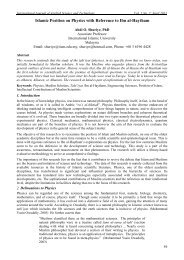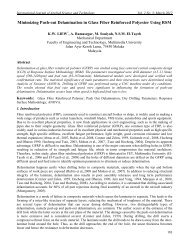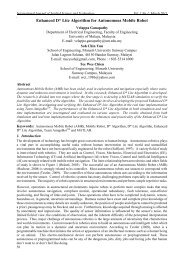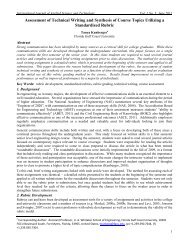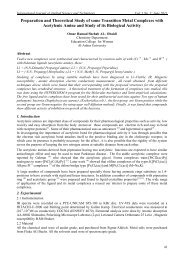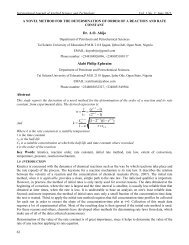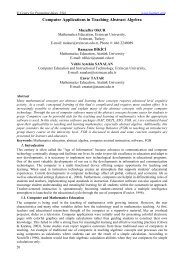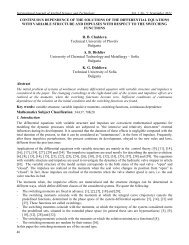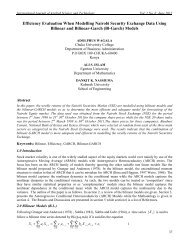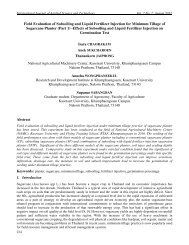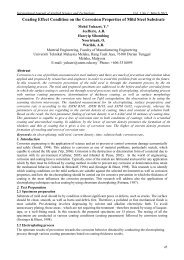Planning Process of Development Project in the Malaysian Context ...
Planning Process of Development Project in the Malaysian Context ...
Planning Process of Development Project in the Malaysian Context ...
You also want an ePaper? Increase the reach of your titles
YUMPU automatically turns print PDFs into web optimized ePapers that Google loves.
International Journal <strong>of</strong> Applied Science and Technology Vol. 1 No. 2; April 2011<br />
<strong>Plann<strong>in</strong>g</strong> <strong>Process</strong> <strong>of</strong> <strong>Development</strong> <strong>Project</strong> <strong>in</strong> <strong>the</strong> <strong>Malaysian</strong> <strong>Context</strong>: A Crucial<br />
Brief Overview<br />
Abdul Aziz Abdullah<br />
Faculty <strong>of</strong> Bus<strong>in</strong>ess Management and Accountancy, Universiti Sultan Za<strong>in</strong>al Abid<strong>in</strong><br />
Gong Badak Campus, 21300 Kuala Terengganu<br />
Terengganu, Malaysia<br />
E-mail: abdulazizum@gmail.com<br />
Zakaria Harun<br />
Department <strong>of</strong> Civil Eng<strong>in</strong>eer<strong>in</strong>g, Faculty <strong>of</strong> Eng<strong>in</strong>eer<strong>in</strong>g<br />
University <strong>of</strong> Malaya, 50603 Kuala Lumpur<br />
Malaysia<br />
E-mail: zakariaharun@um.edu.my<br />
Hamzah Abdul Rahman<br />
Deputy Vice Chancellor, Research and Innovation<br />
University <strong>of</strong> Malaya, 50603 Kuala Lumpur<br />
Malaysia<br />
E-mail: arhamzah1@gmail.com<br />
Abstract<br />
Successful development project is crucial to all project stakeholders. Meet<strong>in</strong>g <strong>the</strong> datel<strong>in</strong>e to complete a<br />
project will be an added advantage for both <strong>the</strong> developer and <strong>the</strong> land owner. <strong>Project</strong> development just like<br />
construction project will encounter some form <strong>of</strong> project life cycle (PLC). A typical PLC <strong>of</strong> developmental<br />
project comprise <strong>of</strong> a <strong>in</strong>itiation and plann<strong>in</strong>g phase, construction phase and post construction phase. Fur<strong>the</strong>r,<br />
<strong>the</strong> implementation <strong>of</strong> <strong>the</strong> one-stop-centre (OSC) by M<strong>in</strong>istry <strong>of</strong> Hous<strong>in</strong>g and Local Government (MHLG)<br />
nationwide <strong>in</strong> April 2007 have succesfully improved <strong>the</strong> delivery system <strong>of</strong> <strong>the</strong> plann<strong>in</strong>g process. As <strong>the</strong> result<br />
<strong>of</strong> <strong>the</strong> MHLG bold step, a more systematic plann<strong>in</strong>g process have benefited <strong>the</strong> developers, consultant and <strong>the</strong><br />
authorities. In lieu <strong>of</strong> this, it is imperative that all <strong>the</strong> consultants and <strong>the</strong> developer should comply to <strong>the</strong><br />
guidel<strong>in</strong>es, rules and regulations stipulated <strong>in</strong> <strong>the</strong> standard manual drawn by Department <strong>of</strong> Town and<br />
Country <strong>Plann<strong>in</strong>g</strong> (DTCP) and <strong>the</strong> MHLG to ascerta<strong>in</strong> a smoo<strong>the</strong>r plann<strong>in</strong>g approval process. Thus, <strong>in</strong> long<br />
run, all <strong>the</strong>se moves implemented by <strong>the</strong> government should attract more foreign direct <strong>in</strong>vestment (FDI).<br />
Key words: <strong>Development</strong> project, plann<strong>in</strong>g process<br />
Introduction<br />
The success <strong>of</strong> a development project as a whole is crucial to all <strong>the</strong> stakeholders who primarily are <strong>the</strong><br />
developer, <strong>the</strong> land owner and property buyer. The timely completion <strong>of</strong> a project that is not only with<strong>in</strong> <strong>the</strong><br />
budget but also <strong>in</strong> accordance to specifications and <strong>the</strong> stakeholder’s satisfaction (Nguyen et al., 2004)<br />
benefits both <strong>the</strong> project owner (developer) and <strong>the</strong> property buyer.<br />
Each and every project development will undergo some form <strong>of</strong> project life cycle (PLC) as mentioned by<br />
Kerzner (2009); PMI (2004). A typical developmental process comprise <strong>of</strong> a <strong>in</strong>itiation and plann<strong>in</strong>g<br />
(predevelopment) stage, a <strong>in</strong>termediate stage (construction) (<strong>in</strong>termediate) and a closer stage (post<br />
development).<br />
<strong>Project</strong> <strong>Development</strong> <strong>the</strong> <strong>Malaysian</strong> <strong>Context</strong>: A crucial brief overview<br />
In <strong>the</strong> <strong>Malaysian</strong> context project development similarly has its own PLC which is divided <strong>in</strong>to three (3) stages,<br />
namely, <strong>the</strong> predevelopment stage, <strong>the</strong> construction stage and <strong>the</strong> post construction stage. The close <strong>of</strong> a<br />
development project or <strong>the</strong> post developmental stage is when <strong>the</strong> completed property is handed over to <strong>the</strong><br />
owner as required and stipulated by <strong>the</strong> Hous<strong>in</strong>g <strong>Development</strong> Act (HDA, 2010). The flow <strong>of</strong> activities<br />
start<strong>in</strong>g from <strong>the</strong> <strong>in</strong>ception right up to <strong>the</strong> delivery <strong>of</strong> a completed property plays a pivotal role <strong>in</strong> <strong>the</strong> plann<strong>in</strong>g<br />
<strong>of</strong> property development. A crucial brief overview <strong>of</strong> a typical plann<strong>in</strong>g process <strong>in</strong> Malaysia, cover<strong>in</strong>g <strong>the</strong><br />
legislature <strong>in</strong> <strong>the</strong> plann<strong>in</strong>g process, <strong>the</strong> development plan and general implementation <strong>of</strong> development plan,<br />
and are as follows.<br />
74
© Centre for Promot<strong>in</strong>g Ideas, USA www.ijastnet .com<br />
Legislature <strong>in</strong> <strong>the</strong> plann<strong>in</strong>g process<br />
The laws, procedures and guidel<strong>in</strong>es perta<strong>in</strong><strong>in</strong>g to <strong>the</strong> property development process <strong>in</strong> Malaysia are quite<br />
extensive. There are over fifty (50) laws and guidel<strong>in</strong>es that may ei<strong>the</strong>r be <strong>in</strong>itiated or pose a constra<strong>in</strong> on<br />
decisions when undertak<strong>in</strong>g a property development project. Those most pert<strong>in</strong>ent and crucial laws to be<br />
complied to <strong>in</strong>clude <strong>the</strong> National Land Code (NLC) 1965 (NLC, 2008), <strong>the</strong> Town and Country <strong>Plann<strong>in</strong>g</strong> Act,<br />
1976 (Act 172), <strong>the</strong> Government Act 1976 (Act 171), Uniform Build<strong>in</strong>g By Law 1984 (UBBL), <strong>the</strong> Street,<br />
Dra<strong>in</strong>age and Build<strong>in</strong>g Act 1974 (Act 133) and <strong>the</strong> Environmental Quality Act 1984.<br />
A very important tool used to manage land development is plann<strong>in</strong>g control, referred to <strong>in</strong> Part IV <strong>of</strong> <strong>the</strong><br />
Town and Country <strong>Plann<strong>in</strong>g</strong> Act (TCPA), 1976 and plann<strong>in</strong>g guidel<strong>in</strong>es. In Section 19, <strong>the</strong> TCPA states that<br />
“no person, o<strong>the</strong>r than <strong>the</strong> local authorities, shall, commence, undertake, or carry out any development unless<br />
plann<strong>in</strong>g permission <strong>in</strong> respect <strong>of</strong> <strong>the</strong> development has been granted to him under Section 22 (treatment <strong>of</strong><br />
application or extended under Subsection 24 (3) (lapse <strong>of</strong> plann<strong>in</strong>g permission)” (LOM, 2006).<br />
<strong>Development</strong> plan<br />
Various development plans (that is, <strong>the</strong> national physical plan; a structure plan, a local plan and a special area<br />
plan) has been formulated under Part III <strong>of</strong> <strong>the</strong> TCPA (TCPA, 1976) <strong>in</strong> order to guide <strong>the</strong> decision makers<br />
when process<strong>in</strong>g plann<strong>in</strong>g permissions. These plans shall form <strong>the</strong> overall policies for future land<br />
development as well as used to establish zon<strong>in</strong>g and plann<strong>in</strong>g standards concern<strong>in</strong>g public facilities<br />
requirements, roads, open spaces, build<strong>in</strong>g setbacks, number <strong>of</strong> car parks etc. Basically, a layout plan that has<br />
been submitted must comply with <strong>the</strong> national and physical plan, <strong>the</strong> state structure plan, <strong>the</strong> local plan, a<br />
special area plan and all plans approved by <strong>the</strong> local authorities <strong>of</strong> <strong>the</strong> govern<strong>in</strong>g state.<br />
The submitt<strong>in</strong>g party is also required to comply with a pre-determ<strong>in</strong>ed zon<strong>in</strong>g requirement, strategic policies<br />
and government policies. For example, <strong>in</strong> <strong>the</strong> state <strong>of</strong> Selangor, any development on a piece <strong>of</strong> land that has<br />
been classified as class 3 and class 4 terra<strong>in</strong>, will not be approved for development by <strong>the</strong> respective local<br />
authority. Similarly, when it <strong>in</strong>volves a composition <strong>of</strong> low cost, medium to low cost and medium cost<br />
hous<strong>in</strong>g and a specific race (that is Bumiputera or <strong>in</strong>digenous group) quota, <strong>the</strong> planner must prepare a layout<br />
plan that takes <strong>in</strong>to consideration government policies, guidel<strong>in</strong>es and o<strong>the</strong>r technical requirements.<br />
General implementation <strong>of</strong> a development plan<br />
A development plan <strong>in</strong> Malaysia is implemented with<strong>in</strong> <strong>the</strong> framework provided under <strong>the</strong> National<br />
<strong>Development</strong> <strong>Plann<strong>in</strong>g</strong> that comes under <strong>the</strong> Town and Country <strong>Plann<strong>in</strong>g</strong> Act, 1976 (Act 172). The National<br />
<strong>Development</strong> <strong>Plann<strong>in</strong>g</strong> Framework (NDPF) comprises <strong>of</strong> three (3) levels <strong>of</strong> plann<strong>in</strong>g (Figure 2.1), namely <strong>the</strong><br />
National Physical Council (NPC) at <strong>the</strong> Federal level, <strong>the</strong> State <strong>Plann<strong>in</strong>g</strong> Committee (SPC) at <strong>the</strong> state level<br />
and <strong>the</strong> local council at <strong>the</strong> local authorities level.<br />
The NDPF is implemented 'top-down' start<strong>in</strong>g at <strong>the</strong> federal level down to <strong>the</strong> state level and f<strong>in</strong>ally to <strong>the</strong><br />
local authorities level, directed towards achieve<strong>in</strong>g a national development vision by <strong>the</strong> year 2020. Any<br />
development <strong>in</strong>volv<strong>in</strong>g land that is more than 100 hectares <strong>in</strong> size requires <strong>in</strong>itial approval from both <strong>the</strong> SPC<br />
and <strong>the</strong> NPC. The NPC is chaired by <strong>the</strong> Prime M<strong>in</strong>ister while <strong>the</strong> SPC is chaired by <strong>the</strong> Chief M<strong>in</strong>ister <strong>of</strong> <strong>the</strong><br />
respective state <strong>of</strong> Malaysia. An approval by <strong>the</strong> state government is required prior to submission for approval<br />
to <strong>the</strong> NPPC for federal government approval.<br />
Both <strong>the</strong> NPPC and SPC convene twice a year to discuss pert<strong>in</strong>ent matters <strong>in</strong>volv<strong>in</strong>g plann<strong>in</strong>g such as a<br />
zon<strong>in</strong>g change, <strong>the</strong> development <strong>of</strong> large parcels <strong>of</strong> land (100 hectares or more), any special development<br />
proposal, gazetted and revocation <strong>of</strong> development plans etc.<br />
75
International Journal <strong>of</strong> Applied Science and Technology Vol. 1 No. 2; April 2011<br />
NATIONAL<br />
DEVELOPMENT<br />
PLANING FRAMEWORK<br />
VISION 2020<br />
Figure 2.1: National <strong>Development</strong> <strong>Plann<strong>in</strong>g</strong> Framework (DTCP, 2005)<br />
76
© Centre for Promot<strong>in</strong>g Ideas, USA www.ijastnet .com<br />
Stages <strong>of</strong> <strong>Development</strong><br />
The three (3) stages <strong>in</strong> a project development are discussed <strong>in</strong> this section. The first stage is <strong>the</strong> plann<strong>in</strong>g stage<br />
or <strong>the</strong> pre-development period. When all required approvals have been obta<strong>in</strong>ed, it <strong>the</strong>n goes <strong>in</strong>to <strong>the</strong> second<br />
stage; <strong>the</strong> construction phase. Dur<strong>in</strong>g <strong>the</strong> post construction stage, that is <strong>the</strong> third stage, a certificate <strong>of</strong><br />
completion <strong>of</strong> compliance (CCC) will be awarded to <strong>the</strong> developer who <strong>the</strong>n would have successfully<br />
completed <strong>the</strong>ir (hous<strong>in</strong>g) project (HDA, 2010, DTCP, 2007). A developer first has to obta<strong>in</strong> all plann<strong>in</strong>g<br />
approvals before any physical work can commence on site and prior to issuance <strong>of</strong> any advertis<strong>in</strong>g permit by<br />
<strong>the</strong> relevant authorities. Under <strong>the</strong> new guidel<strong>in</strong>es by <strong>the</strong> OSC, <strong>the</strong> pr<strong>in</strong>cipal submitt<strong>in</strong>g person (PSP) has an<br />
option to ei<strong>the</strong>r submit all four (4) plann<strong>in</strong>g applications for simultaneous approval or to submit it by stages.<br />
The plann<strong>in</strong>g applications are (a) plann<strong>in</strong>g permission application (Subsection 21[1], Act 172), (b) build<strong>in</strong>g<br />
plan application, (c) road and dra<strong>in</strong>age plan application (Section 9, Act 133) and (d) <strong>the</strong> various 'works' plan<br />
(Section 70A, Act 133). The local authorities shall stipulate conditions subject to comments from <strong>the</strong>ir<br />
technical department. The total number <strong>of</strong> technical departments that exist is peculiar to that local authority<br />
where <strong>the</strong> plans are be<strong>in</strong>g submitted. Just <strong>in</strong> <strong>the</strong> state <strong>of</strong> Selangor, for example, <strong>the</strong>re are a total <strong>of</strong> fourteen<br />
(14) technical departments (DTCP, 2007; MHLG, 2008) with whom <strong>the</strong> PSP must work with dur<strong>in</strong>g <strong>the</strong><br />
submission <strong>of</strong> plans.<br />
Any development that <strong>in</strong>volves land area larger than 50 hectares <strong>in</strong> size, is required to be supported by a study<br />
on <strong>the</strong> potential impact it may have on <strong>the</strong> local environment (DTCP, 2007). The environental impact<br />
assessment (EIA) study is a requirement imposed by <strong>the</strong> authorities on <strong>the</strong> pr<strong>in</strong>cipal submitt<strong>in</strong>g party (PSP)<br />
where <strong>the</strong> submitted plans must go through <strong>the</strong> various technical departments (DTCP, 2007; MHLG, 2008),<br />
for example <strong>the</strong> department <strong>of</strong> environment, that handles all matters perta<strong>in</strong><strong>in</strong>g to <strong>the</strong> environment, <strong>the</strong><br />
Department <strong>of</strong> Sewerage on matters concern<strong>in</strong>g sewerage, <strong>the</strong> Department <strong>of</strong> Dra<strong>in</strong>age on dra<strong>in</strong>age matters<br />
and <strong>the</strong> Board <strong>of</strong> Water Management that manages water matters. O<strong>the</strong>r standard compliances <strong>in</strong>clude <strong>the</strong><br />
build<strong>in</strong>g setback l<strong>in</strong>e requirement for different build<strong>in</strong>g types (hous<strong>in</strong>g, <strong>in</strong>dustrial, or commercial), density,<br />
plot ratios, public facilities, retention ponds, supply <strong>of</strong> electricity (by <strong>the</strong> National Board <strong>of</strong> Electricity) and<br />
road levels. All plann<strong>in</strong>g approvals is subject to <strong>the</strong> plann<strong>in</strong>g permission process referred to under Section<br />
IV, Town and Country <strong>Plann<strong>in</strong>g</strong> Act, 1976 (Act 172). Generally, <strong>the</strong> local authorities would only <strong>of</strong>fer an<br />
<strong>in</strong>itial conditional approval. The submitt<strong>in</strong>g party, that is <strong>the</strong> planner (appo<strong>in</strong>ted by <strong>the</strong> developer), shall <strong>the</strong>n<br />
make <strong>the</strong> necessary amendments <strong>in</strong> compliance with to <strong>the</strong> requirements stated <strong>in</strong> <strong>the</strong> letter <strong>of</strong> conditional<br />
approval issued by <strong>the</strong> various technical departments. The development plann<strong>in</strong>g approval process is shown <strong>in</strong><br />
Figure 2.2.<br />
Figure 2.2. <strong>Process</strong> <strong>of</strong> development approval (DTCP, 2007; MHLG, 2008)<br />
77
International Journal <strong>of</strong> Applied Science and Technology Vol. 1 No. 2; April 2011<br />
Prelim<strong>in</strong>ary discussions will take place between <strong>the</strong> plann<strong>in</strong>g consultant and <strong>the</strong> plann<strong>in</strong>g department at <strong>the</strong><br />
respective local authorities dur<strong>in</strong>g <strong>the</strong> layout plan or plann<strong>in</strong>g permission submission process. Here, <strong>the</strong><br />
planners shall endeavour to work toge<strong>the</strong>r with <strong>the</strong> plann<strong>in</strong>g department <strong>of</strong> <strong>the</strong> respective local authorities on<br />
fulfill<strong>in</strong>g <strong>the</strong> checklist requirement prior to submitt<strong>in</strong>g a f<strong>in</strong>al layout plan for approval.<br />
The above mentioned checklist (DTCP, 2007) forms part <strong>of</strong> <strong>the</strong> plann<strong>in</strong>g requirements endorsed by <strong>the</strong><br />
M<strong>in</strong>istry <strong>of</strong> Hous<strong>in</strong>g and Local Government (MHLG) and <strong>in</strong>cluded also <strong>in</strong> <strong>the</strong> manual for plann<strong>in</strong>g standard<br />
guidel<strong>in</strong>es for <strong>the</strong> state <strong>of</strong> Selangor by <strong>the</strong> Department Town and Country <strong>Plann<strong>in</strong>g</strong> (DTCP). <strong>Plann<strong>in</strong>g</strong><br />
guidel<strong>in</strong>es that orig<strong>in</strong>ate from <strong>the</strong> DTCP, Pen<strong>in</strong>sular Malaysia (Federal Government) are also adopted by <strong>the</strong><br />
o<strong>the</strong>r states <strong>in</strong> Malaysia. In addition to <strong>the</strong> plann<strong>in</strong>g standards <strong>the</strong>re are fifty-five (55) o<strong>the</strong>r specific guidel<strong>in</strong>es<br />
stipulated (MHLG, 2008). This checklist evolves over time <strong>in</strong> order to address any changes as required by <strong>the</strong><br />
State and Federal government allowed by various Acts and Bylaws.<br />
Where necessary, <strong>the</strong> submitt<strong>in</strong>g party is allowed to submit an appeal to <strong>the</strong> local authorities on any<br />
requirement deemed unfavourable dur<strong>in</strong>g this process. The appeal may be to reta<strong>in</strong> aspects <strong>of</strong> <strong>the</strong> <strong>in</strong>itial<br />
proposal or to negotiate <strong>the</strong> conditions imposed on <strong>the</strong> <strong>in</strong>itial submission proposal. In some cases, <strong>the</strong><br />
consultant would propose several alternatives <strong>in</strong> order to comply to <strong>the</strong> requirement under <strong>the</strong> conditional<br />
approval. Only when <strong>the</strong> necessary amendments have been made and <strong>the</strong> list <strong>of</strong> requirements <strong>in</strong> <strong>the</strong><br />
conditional approval have been fulfilled, can <strong>the</strong> submitt<strong>in</strong>g party obta<strong>in</strong> an endorsement <strong>of</strong> approval by <strong>the</strong><br />
local authorities (MHLG, 2008). Should a plann<strong>in</strong>g permission be rejected, that developer may appeal to <strong>the</strong><br />
Appeals Board under Section 36, Town and Country <strong>Plann<strong>in</strong>g</strong> Act, 1976 (Act 172), that is set up under <strong>the</strong><br />
Department <strong>of</strong> Town and Country <strong>Plann<strong>in</strong>g</strong> (DTCP), State Office (at every state <strong>of</strong> Malaysia).<br />
The flow chart <strong>of</strong> <strong>the</strong> plann<strong>in</strong>g process for a local authority, for example <strong>the</strong> state <strong>of</strong> Selangor, is shown <strong>in</strong><br />
Appendix A (MHLG, 2008). This chart shows <strong>the</strong> concurrent submission application <strong>of</strong> a development<br />
proposal, <strong>in</strong>dicat<strong>in</strong>g <strong>the</strong> relevant departments for approvals and <strong>the</strong> flow <strong>of</strong> activities start<strong>in</strong>g from submission<br />
right up to completion <strong>of</strong> <strong>the</strong> plann<strong>in</strong>g process. The time frame that is targeted by <strong>the</strong> OSC to complete every<br />
plann<strong>in</strong>g approval process is also <strong>in</strong>dicated <strong>in</strong> this chart.<br />
One-Stop-Centre (OSC)<br />
In April 2007, <strong>the</strong> <strong>Malaysian</strong> government under <strong>the</strong> M<strong>in</strong>istry <strong>of</strong> Hous<strong>in</strong>g and Local government (MHLG)<br />
<strong>in</strong>itiated a One-Stop-Centre (OSC) approval process <strong>in</strong> an effort to improve <strong>the</strong> delivery system and<br />
procedures at all state municipalities. Its ma<strong>in</strong> purpose is to ensure that Malaysia stays globally competitive <strong>in</strong><br />
<strong>the</strong> property and real estate sectors (MHLG, 2008). It is an <strong>in</strong>dependant body that acts as a facilitator for <strong>the</strong><br />
plann<strong>in</strong>g process for submission <strong>of</strong> plans at <strong>the</strong> local authority. Currently <strong>the</strong> OSC forms part <strong>of</strong> <strong>the</strong> local<br />
authority located <strong>in</strong> every state <strong>in</strong> Malaysia.<br />
Prior to <strong>the</strong> <strong>in</strong>troduction <strong>of</strong> <strong>the</strong> OSC, submission for approval was done separately and <strong>in</strong> sequence. Only upon<br />
approval <strong>of</strong> <strong>the</strong> layout plan can <strong>the</strong> build<strong>in</strong>g plan be submitted for approval with <strong>the</strong> rest <strong>of</strong> <strong>the</strong> draw<strong>in</strong>gs to<br />
follow suit. With <strong>the</strong> implementation <strong>of</strong> <strong>the</strong> OSC, <strong>the</strong> consultants have <strong>the</strong> option to submit all five (5)<br />
draw<strong>in</strong>gs, namely <strong>the</strong> layout plan, build<strong>in</strong>g plan, road and dra<strong>in</strong>age plan, earthwork plan and landscape plan<br />
simultaneously (DTCP, 2007; MHLG, 2008).<br />
Pr<strong>in</strong>cipal Submitt<strong>in</strong>g Party (PSP)<br />
The planner (registered planner) is pr<strong>in</strong>cipal submitt<strong>in</strong>g party (PSP) engaged by <strong>the</strong> developer or land owner<br />
to prepare <strong>the</strong> layout plan and will act as PSP for all plann<strong>in</strong>g approvals, primarily at <strong>the</strong> plann<strong>in</strong>g permission<br />
stage (refer to Appendix A). In smaller development projects, <strong>the</strong> architect acts as PSP to complete and obta<strong>in</strong><br />
<strong>the</strong> build<strong>in</strong>g plan approval from <strong>the</strong> local authorities. The civil and structural (C and S) eng<strong>in</strong>eer is required to<br />
produce <strong>the</strong> platform design for <strong>the</strong> earthworks plan application. The C and S eng<strong>in</strong>eer also prepares <strong>the</strong><br />
structural build<strong>in</strong>g design for <strong>the</strong> architect to submit at <strong>the</strong> build<strong>in</strong>g plan approval stage. Similarly, <strong>the</strong><br />
mechanical and electrical (M and E) eng<strong>in</strong>eers prepares <strong>the</strong> mechanical and electrical draw<strong>in</strong>gs and layout to<br />
<strong>in</strong>clude plumb<strong>in</strong>g, electrical supply and <strong>the</strong> sewerage treatment plant (STP) for submission at <strong>the</strong> build<strong>in</strong>g<br />
plan approval stage.<br />
The key consultant who is responsible for coord<strong>in</strong>at<strong>in</strong>g <strong>the</strong> works activities at <strong>the</strong> <strong>in</strong>itial stage <strong>of</strong> submission <strong>of</strong><br />
<strong>the</strong> layout plan with <strong>the</strong> authorities shall be <strong>the</strong> planner. A registered planner must fullfill two (2)<br />
requirements, that is (a) be registered as a corporate member with <strong>the</strong> <strong>Malaysian</strong> Institute <strong>of</strong> Planners (MIP)<br />
and (b) be registered with <strong>the</strong> <strong>Malaysian</strong> <strong>Plann<strong>in</strong>g</strong> Board. The registered planner, be<strong>in</strong>g <strong>the</strong> consultant or <strong>the</strong><br />
PSP act<strong>in</strong>g on behalf <strong>of</strong> <strong>the</strong> developer, must ensure full compliance with all <strong>the</strong> requirements stipulated by <strong>the</strong><br />
local authorities and technical departments.<br />
78
© Centre for Promot<strong>in</strong>g Ideas, USA www.ijastnet .com<br />
In <strong>the</strong> state <strong>of</strong> Selangor, <strong>the</strong> local authorities, for example, has prepared a manual <strong>of</strong> standard procedure and<br />
guidel<strong>in</strong>es (DTCP, 2007) as a reference and a guide for consultants, developers or land owners. These<br />
guidel<strong>in</strong>es must be followed when submitt<strong>in</strong>g a development proposal for approval.<br />
Relationship between Pr<strong>in</strong>cipal Submitt<strong>in</strong>g Persons (PSP) and Approv<strong>in</strong>g Authorities<br />
A good work<strong>in</strong>g relationship between <strong>the</strong> consultant, <strong>the</strong> developer and <strong>the</strong> various respective departments at<br />
<strong>the</strong> local authorities will directly contribute to a successful plann<strong>in</strong>g approval. The consultant must keep<br />
abreast <strong>of</strong> all requirements stipulated by <strong>the</strong> authorities. Where <strong>in</strong> doubt, <strong>the</strong> manual for plann<strong>in</strong>g guidel<strong>in</strong>es<br />
and procedures for <strong>the</strong> State <strong>of</strong> Selangor (DTCP, 2007) is available.<br />
It is imperative for <strong>the</strong> developer <strong>of</strong> a hous<strong>in</strong>g project to comply with <strong>the</strong> plann<strong>in</strong>g standard guidel<strong>in</strong>e (DTCP,<br />
2007; MHLG, 2008) <strong>of</strong> that respective local authority where <strong>the</strong> project is located. This is easily achievable by<br />
cooperat<strong>in</strong>g with <strong>the</strong> plann<strong>in</strong>g consultant (registered planner). A lack <strong>of</strong> cooperation <strong>in</strong> any aspect may result<br />
<strong>in</strong> a protracted conditional approval and a delay to obta<strong>in</strong> <strong>the</strong> endorsement for f<strong>in</strong>al approval hence delay<strong>in</strong>g<br />
<strong>the</strong> overall construction.<br />
<strong>Plann<strong>in</strong>g</strong> Approv<strong>in</strong>g Committee<br />
The plann<strong>in</strong>g approval is decided by <strong>the</strong> plann<strong>in</strong>g approval committee at <strong>the</strong> local authorities where <strong>the</strong> OSC<br />
is located. The committee is chaired by <strong>the</strong> head (Mayor) <strong>of</strong> <strong>the</strong> local authority and comprises <strong>of</strong> sixteen (16)<br />
representatives from <strong>the</strong> respective technical departments, local authorities’ councillors (representatives <strong>of</strong> <strong>the</strong><br />
local municipalities selected by <strong>the</strong> state) (Appendix B). The head <strong>of</strong> <strong>the</strong> plann<strong>in</strong>g department at <strong>the</strong> local<br />
authority is responsible for submitt<strong>in</strong>g <strong>the</strong> development report on each layout plan submission. The report and<br />
<strong>the</strong> layout plan are <strong>the</strong>n tabled at <strong>the</strong> OSC meet<strong>in</strong>g for approval. Appendix B is a typical example <strong>of</strong> a full<br />
plann<strong>in</strong>g approval committee for <strong>the</strong> state <strong>of</strong> Selangor headed by <strong>the</strong> Town Councillor (Yang di Pertua) for<br />
State Municipality or Mayor (Datuk Bandar) for City Municipality.<br />
Conclusion<br />
The M<strong>in</strong>istry <strong>of</strong> Hous<strong>in</strong>g and Local Government (MHLG) took a bold step <strong>in</strong> implement<strong>in</strong>g <strong>the</strong> One-Stop-<br />
Centre (OSC) at each local authority nationwide <strong>in</strong> April 2007. The primary goal to improve <strong>the</strong> delivery<br />
system <strong>of</strong> <strong>the</strong> plann<strong>in</strong>g process (MHLG, 2008), specifically to ensure a “smooth sail<strong>in</strong>g” procedure for<br />
property developers and consultants alike is anticipated to attract more foreign direct <strong>in</strong>vestment (FDI) to<br />
<strong>in</strong>vest <strong>in</strong> <strong>the</strong> local property market. Prior to <strong>the</strong> OSC, it was a laborious submission process <strong>in</strong>volv<strong>in</strong>g two<br />
levels <strong>of</strong> approvals that is a) change <strong>of</strong> land status <strong>in</strong>volv<strong>in</strong>g <strong>the</strong> land <strong>of</strong>fice and b) obta<strong>in</strong><strong>in</strong>g <strong>the</strong> plann<strong>in</strong>g<br />
approval (Local Authorities <strong>Plann<strong>in</strong>g</strong> Department). At <strong>the</strong> former, applications ei<strong>the</strong>r went for conversion and<br />
subdivision simultaneously under Section 124A (NLC, 2008) or surrender and alienation under Section 204D<br />
(NLC, 2008; MHLG, 2008).<br />
The plann<strong>in</strong>g application for proposed development first goes through <strong>the</strong> local authorities plann<strong>in</strong>g<br />
department under <strong>the</strong> <strong>Plann<strong>in</strong>g</strong> Permission under Subsection 21(1), Act 172. The subsequent approval at <strong>the</strong><br />
Local Authorities Build<strong>in</strong>g Department is <strong>the</strong> Build<strong>in</strong>g <strong>Plann<strong>in</strong>g</strong> Approval under Section 70 Act 133 (MHLG,<br />
2008). Only when <strong>the</strong> build<strong>in</strong>g plan is approved, <strong>the</strong> application will <strong>the</strong>n go through to <strong>the</strong> Local Authorities<br />
Eng<strong>in</strong>eer<strong>in</strong>g Department for <strong>the</strong> Road and Dra<strong>in</strong>age Plan Approval under Section 70 Act133 and Earthworks<br />
Plan under Section 70A Act 133 (MHLG, 2008). It is imperative that all <strong>the</strong> consultants who are <strong>the</strong><br />
Pr<strong>in</strong>cipal Submitt<strong>in</strong>g Parties (PSP) properly and fully comply with <strong>the</strong> rules and regulations stipulated <strong>in</strong> <strong>the</strong><br />
standard manual procedure and guidel<strong>in</strong>es by DTCP (2007) and <strong>the</strong> MHLG (2008) <strong>in</strong> order to ascerta<strong>in</strong> a<br />
smooth plann<strong>in</strong>g approval process. The acts and <strong>the</strong> by-laws <strong>of</strong> both federal and <strong>the</strong> state government must be<br />
complied to at all stages <strong>of</strong> <strong>the</strong> plann<strong>in</strong>g approval process <strong>in</strong> order to obta<strong>in</strong> approval from <strong>the</strong> state<br />
municipalities. For example, <strong>in</strong> <strong>the</strong> state <strong>of</strong> Selangor, <strong>the</strong> plann<strong>in</strong>g process constitut<strong>in</strong>g <strong>the</strong> procedures and<br />
policies are as prescribed <strong>in</strong> <strong>the</strong> Manual for Standard Guidel<strong>in</strong>es for Town and Country <strong>Plann<strong>in</strong>g</strong>, Selangor<br />
(DTCP 2007; MHLG, 2008).<br />
References<br />
Board <strong>of</strong> Architect Malaysia (2007). Certificate <strong>of</strong> Completion and Compliance. General Circular No. 1/2008 Retrieved<br />
on 19 th April 2010 from http://www.lam.gov.my/download/1_2008.pdf.<br />
Department <strong>of</strong> Town and Country <strong>Plann<strong>in</strong>g</strong>, Selangor (2005). National Physical Plan. M<strong>in</strong>istry <strong>of</strong> Hous<strong>in</strong>g and Local<br />
Government Malaysia, Malaysia.<br />
Department <strong>of</strong> Town and Country <strong>Plann<strong>in</strong>g</strong>, Selangor, (2007). Manual for Standard Procedures and Guidel<strong>in</strong>es (3 rd ed.).<br />
State Government <strong>of</strong> Selangor, Malaysia.<br />
Hous<strong>in</strong>g <strong>Development</strong> Act (2010). Hous<strong>in</strong>g <strong>Development</strong> (Control and Licens<strong>in</strong>g) Act, 1966 (Act 188). Published by <strong>the</strong><br />
Commissioner <strong>of</strong> Law Revision, Malaysia under <strong>the</strong> authority <strong>of</strong> <strong>the</strong> revision <strong>of</strong> Laws Act 1968 <strong>in</strong><br />
79
International Journal <strong>of</strong> Applied Science and Technology Vol. 1 No. 2; April 2011<br />
Collaboration with Percetakan Nasional Malaysia Bhd. Retrieved on 9 th June 2010 from<br />
http://www.agc.gov.my/agc/Akta/Vol.%203/Act%20118.pdf.<br />
Kerzner H (2009). <strong>Project</strong> Management: A System Approach to <strong>Plann<strong>in</strong>g</strong>, Schedul<strong>in</strong>g,<br />
and Controll<strong>in</strong>g (10 th ed.). New York: Van Nostrand.<br />
Laws <strong>of</strong> Malaysia (2006), Town and Country <strong>Plann<strong>in</strong>g</strong> Act, 1976 (Act 172). The Commissioner <strong>of</strong> Law Revision<br />
Malaysia. Malaysia: Percetakan Nasional Malaysia Bhd<br />
M<strong>in</strong>istry <strong>of</strong> Hous<strong>in</strong>g and Local Government, Malaysia (2008). Upgrad<strong>in</strong>g <strong>of</strong> <strong>the</strong> Procedure on <strong>the</strong> Delivery System and<br />
<strong>Development</strong> Plan <strong>Process</strong> and <strong>the</strong> Implementation <strong>of</strong> <strong>the</strong> One Stop Centre (2 nd ed.). Pusat Bandar Damansara, Kuala<br />
Lumpur, Malaysia.<br />
National Land Code (2008). National Land Code (Act 56 <strong>of</strong> 1965) & Regulations, International Law Books Services,<br />
Petal<strong>in</strong>g Jaya, Selangor, Malaysia.<br />
Nguyen LD, Ogunlana SO, Lan, DTX (2004). A study on project success factors <strong>in</strong> large construction projects <strong>in</strong><br />
Vietnam. Eng<strong>in</strong>eer<strong>in</strong>g, Construction and Architectural Management, 11 (6), 404-413.<br />
PMI (2004). A Guide to <strong>the</strong> <strong>Project</strong> Management Body <strong>of</strong> Knowledge. <strong>Project</strong> Management Institute (PMI),<br />
Pennsylvania.<br />
APPENDIX A<br />
Flow Chart <strong>of</strong> Concurrent Application for Proposal <strong>Development</strong> (MHLG, 2008)<br />
80
© Centre for Promot<strong>in</strong>g Ideas, USA www.ijastnet .com<br />
APPENDIX B<br />
DECISION MAKERS AT THE ONE-STOP-CENTRE (OSC)<br />
Membership <strong>of</strong> <strong>the</strong> Committee Members <strong>of</strong> <strong>the</strong> One-Stop-Centre (OSC)<br />
The follow<strong>in</strong>g are <strong>the</strong> Committee Membership <strong>of</strong> <strong>the</strong> OSC:<br />
Chairman : Mayor<br />
Secretary : OSC Director<br />
Members : 1. Deputy Mayor<br />
2. 4 Ord<strong>in</strong>ary Members <strong>of</strong> <strong>the</strong> Council<br />
3. Director <strong>of</strong> State Urban and Town <strong>Plann<strong>in</strong>g</strong><br />
4. Director <strong>of</strong> M<strong>in</strong>eral and Land<br />
5. Land Adm<strong>in</strong>istrator<br />
6. Director <strong>of</strong> Public Works<br />
7. Director <strong>of</strong> Department <strong>of</strong> Dra<strong>in</strong>age and Irrigation<br />
8. Director <strong>of</strong> Department <strong>of</strong> Environment<br />
9. Director <strong>of</strong> Department <strong>of</strong> Fire Fighter and Life Sav<strong>in</strong>g<br />
10. Director <strong>of</strong> Department <strong>of</strong> Sewage Services<br />
11. Manager <strong>of</strong> Tenaga Nasional Berhad<br />
12. Manager <strong>of</strong> Telekom Malaysia Berhad<br />
13. Manager <strong>of</strong> Department <strong>of</strong> <strong>Plann<strong>in</strong>g</strong><br />
14. Manager <strong>of</strong> Department <strong>of</strong> Build<strong>in</strong>g<br />
15. Manager <strong>of</strong> Department <strong>of</strong> Eng<strong>in</strong>eer<strong>in</strong>g<br />
16. Manager <strong>of</strong> Department <strong>of</strong> Landscape<br />
17. Manager <strong>of</strong> Department <strong>of</strong> Health<br />
18. Technical Departments that are related are <strong>in</strong>vited<br />
81



